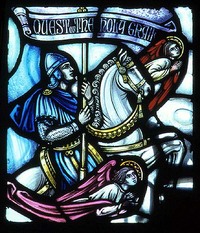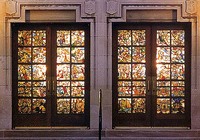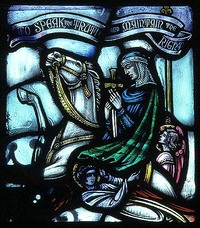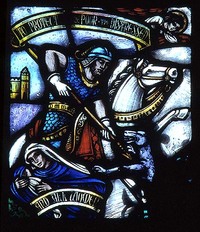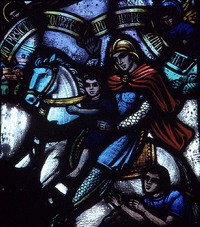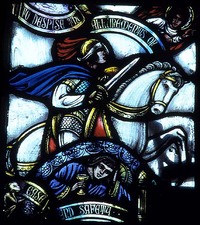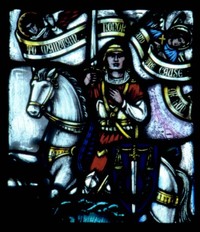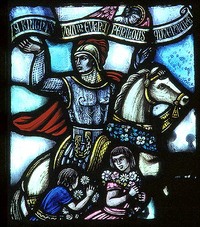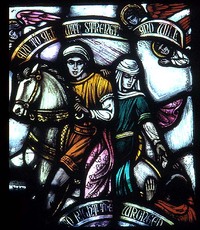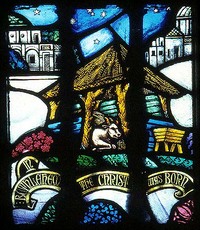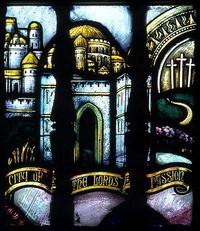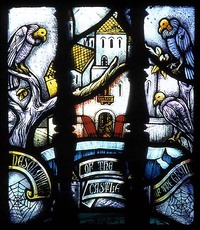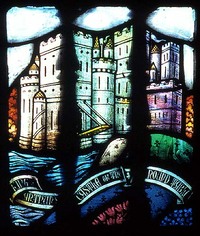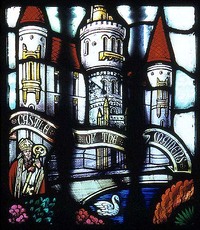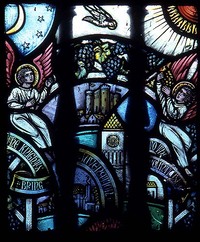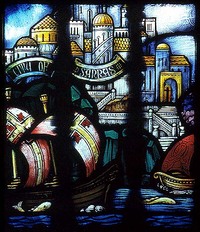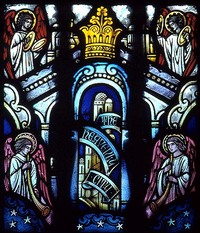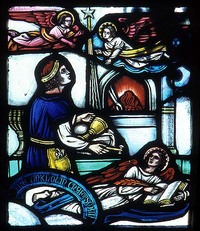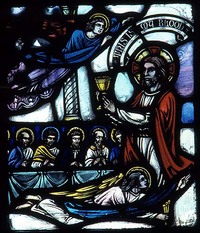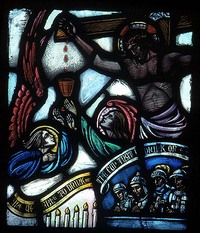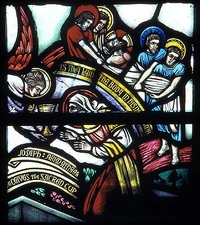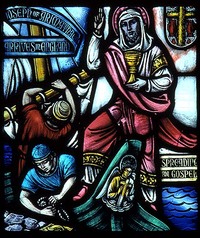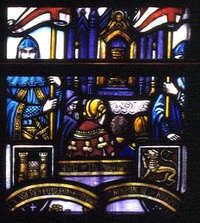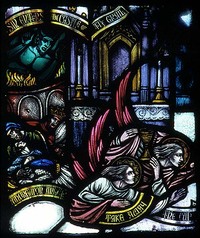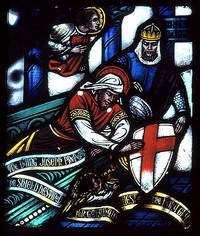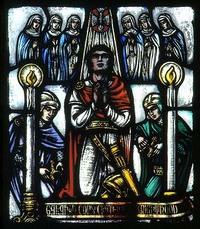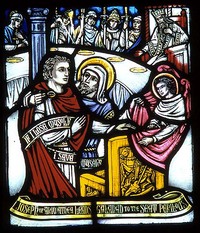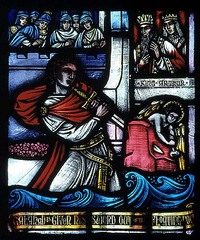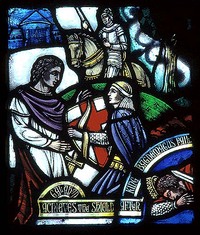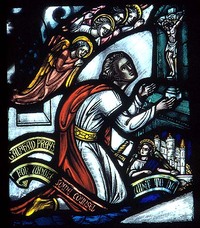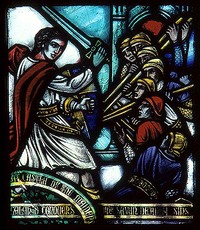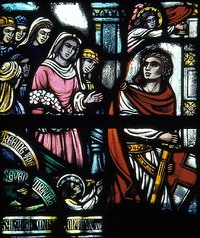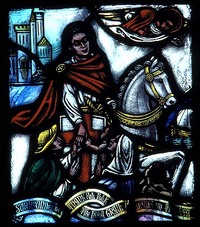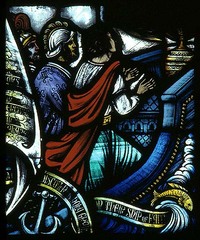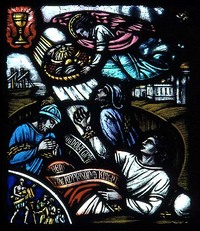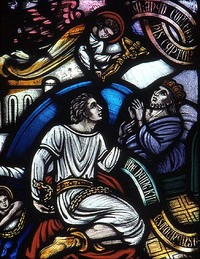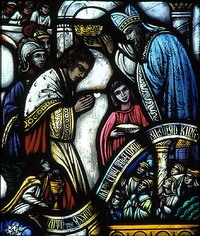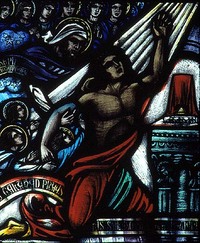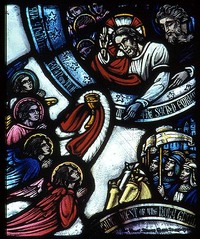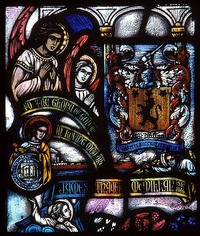MSGC : Featured Windows : Current Window
Featured Windows, January 2004
Grosse Pointe Memorial Church Doors
Building: Grosse Pointe Memorial Church
City: Grosse Pointe Farms
State: Michigan
This month's featured "window," is in fact a most stunning and highly unusual use of stained glass on the entry doors of a Presbyterian church in the Detroit suburb of Grosse Pointe Farms.
The four narthex doors hold ten stained glass panels each, measuring 12 1/2" high x 10 1/2" wide, and depicting scenes from Arthurian legend. The panels were designed by Henry Lee Willet of the Willet Studios of Philadelphia and were completed in 1948. The panels are made from hand blown pot metal glasses and Norman slabs.
The eight panels across the tops of the four doors portray vows taken by the Knights of the Round Table, such as "To speak the truth and maintain the right" and "To practice courtesy and kindness with all."
Across the bottoms of the doors are cities and places that appear in the story of the quest, like "King Arthur's Castle" and the "Castle of the Maidens."
The legend of the Holy Grail is told in remarkable detail in the remaining twenty-four panels, six in each door.
Stained glass with literary subject matter is far less common in churches than that based on sacred texts like the Bible for obvious reasons, but it is not unheard of. Literary windows in churches often reflect the tastes of those to whom they are donated in memory of and more affluent, literate congregations use literary windows to express their collective inclinations towards "high" cultural pursuits. More generally speaking, literary stained glass appears in a variety of settings, including libraries, clubs, universities, homes and cemeteries. The nature of its subject matter can be simple, like the portrait of an author or character from a famous work, or it can represent an elaborate representation of a scene from a work. It might include text from the work represented, or it might be expected that the viewer is literate enough to know the work being portrayed. Some literary works portray allegorical figures like Muses, and others are essentially nonrepresentational, showing only the words of the literary text.
The earliest known example of a stained glass window with a literary theme in Europe was produced for the Tucher family of Nuremberg in the sixteenth century, which illustrated Greek and Roman myths. In the nineteenth century literary imagery and, in particular, medievalist imagery inspired by Arthurian legend inspired the work of Englishman William Morris and his circle of contemporaries. Pre-Raphaelite paintings and Arts and Crafts tapestries drew inspiration from the texts of Arthurian legend, as did the subject matter of stained glass the same artists produced. Morris and Company (including painters Edward Burne-Jones and Dante Gabriel Rosetti who designed the windows) produced twelve 1862 windows on the story of Tristram and Isoude for the home of a Yorkshire merchant. Burne-Jones also designed an 1886 series based on Galahad's quest for the holy grail for his own home, then gave them to a neighbor, Lady Leighton Warren at Rottingdean. The appearance of Arthurian windows in churches appears in part to have begun after World War I as a means of memorializing dead soldiers. The imagery of valor in battle, spiritual fulfillment and heavenly reward as presented in Malory's particular text of Arthurian legend and as interpreted by the the stained glass artist can have as much of a spiritual meaning as it would have secular.
Arthurian legend as we understand it today through popular culture is often secularized and focuses primarily on the final episodes of the stories known as the Morte d'Arthur--the stories of Arthur, Lancelot and Guenevere. The whole story is actually an episodic collection of legends, based on the histories of certain early British kings, Celtic legends, courtly love traditions, and orthodox Christian belief. It is drawn from a number of texts (English and French), and continues to be modified in poetry, fiction and film, but the most well known is that of Thomas Malory (d. 1471), who wrote the Morte d'Arthur
In Part VI of the Morte D'Arthur, "Sankgreall," tells how Galahad becomes a member of the Round Table, all the knights depart on the Quest of the Holy Grail. Galahad, accompanied by Percival and Bors, achieves the Grail before his death, and only Bors returns. Lancelot also partially succeeds, and the others fail. In Willet's interpretation of the Sankgreall, he focuses entirely on Galahad's quest as opposed to other figures like Lancelot and he also draws attention to the religious signification of the Grail and the reading of Arthurian legend as a religious text. The Grail was thought to be the vessel in which Christ's blood from the cross was received, but the idea also has roots in pagan Gaelic culture. Willet shows the spilling of Christ's blood into the Grail as well as Joseph of Arimathea delivering the Grail to England and prophesying the arrival of Galahad, who will one day recover the sacred cup after it is lost from the Castle of the Grail upon the arrival of Sin. Joseph of Arimathea plays a key role in the narrative as Willet portrays it, serving as the link between biblical past and Arthurian "present"--and consequently appearing in several of the door panels. While a secular reading could focus on other aspects of Arthurian legend from chivalric virtues to adventure and betrayal to love and marriage, Willet foregrounds the Sankgreall's links to Christian struggles and a triumph of the soul.
The Grosse Pointe Memorial doors were donated by Mrs. Anne Russel McMillan in memory of her husband, James Thayer McMillan. They are but one aspect of a large collection of elaborate and beautiful stained glass that the church developed between 1927 and 1952, all by the Willet Studios. Grosse Pointe Memorial Church was dedicated on May 15, 1927. Detroit architect W.E.N. Hunter designed the Neo-Gothic limestone structure, which also contains Pewabic tiles, and wood carvings by German carver Alois Lang. The church was dedicated to the founders, who organized the non-denominational Grosse Pointe Protestant Evangelical Church on September 7, 1865. In 1867 the first church was erected at Kerby Road and Lake Shore Drive. A stone and wood-frame building, referred to as the "ivy-covered church," was originally built on the site in 1894. In 1920 the congregation reorganized as a Presbyterian church. Grosse Pointe Memorial was added to the State Register of Historic Sites in 1991. For other examples of literary stained glass windows, see the windows of the month for
March 2000,
August 2001 and
May 2002.
Grosse Pointe Memorial Church was registered in the Michigan Stained Glass Census by Jeanette Smith and Anne Parcells of Grosse Pointe.
Bibliography:
Show BibliographyBrewer, D.S., ed. Malory: The Morte Darthur. (Evanston: Northwestern University Press, 1989).
Malory, Thomas. The Holy Grail. http://www.bartleby.com/35/2/.
Mancoff, Debra M. Burne-Jones. Rohnert Park, CA: Pomegranite, 1998.
Weis, Helene H. "Illuminated Literature," Stained Glass Quarterly. Fall, 1990, 212-216. (MSGC 1996.0043)
Text by Michele Beltran, Michigan Stained Glass Census, January , 2004.

